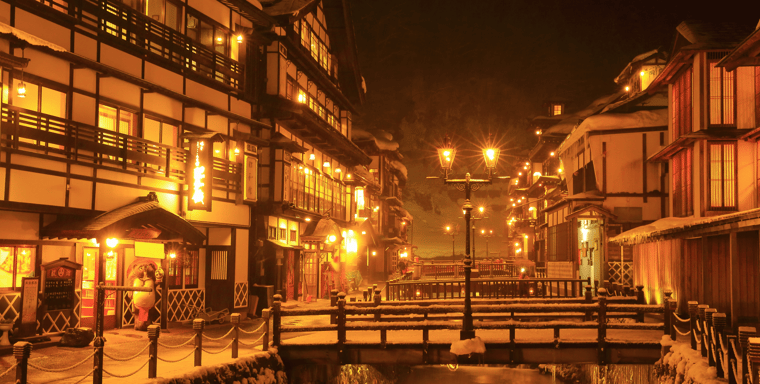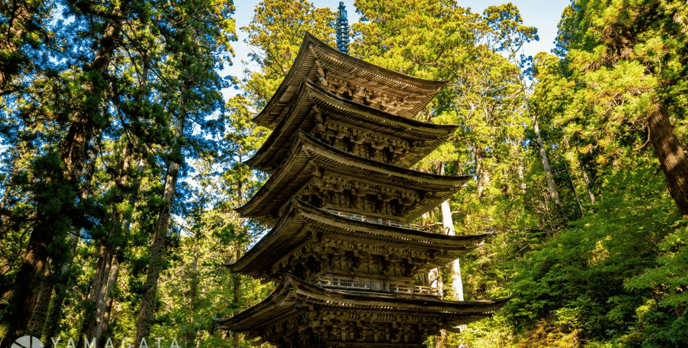🕓 2023/11/25
#観光地

What is Yamagata?
Yamagata Prefecture is a picturesque area located in the Tohoku region of Japan. Its beautiful nature and historical background make it highly attractive to foreign tourists.
Known as Dewa since ancient times, Yamagata Prefecture is an area where Mogami culture, centered around Mogami Yoshiaki, flourished, and its unique culture was developed by two feudal lords, the Yonezawa Clan and the Shonai Clan.
Yamagata Prefecture is home to numerous attractions that captivate tourists, such as the Zao mountain range, Risshakuji Temple, and the beautiful landscapes along the Shonai Plain. In addition, local cuisine made from local ingredients and traditional crafts are also part of the fun of sightseeing.
Top 3 Selected Tourist Attractions in Yamagata
1. The Hagurosan Five

● Attractions
The Hagurosan Five-Story Pagoda attracts numerous visitors for its historical significance and aesthetic appeal. Standing approximately 29 meters tall, this three-bay, five-tiered structure is roofed with traditional wooden shingles and constructed in undecorated raw wood, representing a classic example of Japanese ancient architecture. The pagoda, especially amidst snow, is a popular sight for tourists and photographers alike.
● History
The history of the Hagurosan Five-Story Pagoda dates back to the Heian period, reportedly founded by Taira no Masakado during 931-938 AD. However, the current structure was reconstructed around 1372 during the Muromachi period. During the Edo period, the area around the pagoda was home to many buildings. Post the separation of Shinto and Buddhism, it enshrined Ōkuninushi-no-Mikoto and became part of the Dewa Sanzan Shrine as the "Chiyori Sha."
● Access
- Address: Haguro, Tsuruoka City, Yamagata Prefecture
- Google Maps Link: Hagurosan Five-Story Pagoda Location
- Walking Access: About 15 minutes on foot from Zuijinmon, and approximately 30-40 minutes from the summit.
- Public Transportation: The nearest railway station is Tsuruoka Station, from where buses are available to Hagurosan. Buses operated by Yamagata Kotsu can also be taken to the entrance of Hagurosan.
2. The Kaizandō, located within the Risshaku-ji Temple

● Attractions
The Kaizandō, located within the Risshaku-ji Temple in Yamagata City, Yamagata Prefecture, offers a unique glimpse into the rich history of ancient Japanese Buddhism and art. The building features traditional Japanese architectural styles such as irimoya (hip-and-gable roof), chidori-hafu (plover gable), copper roofing, and intricate carvings of dragons, lions, and phoenixes. Inside, a wooden statue of the founder, Ennin (Jikaku Daishi), provides a profound historical experience. The Kaizandō is not only a significant spot within Risshaku-ji but also a place where visitors can experience the beauty of Japanese Buddhist culture and ancient architecture.
● History
Risshaku-ji Temple, according to tradition, was founded in 860 AD by Ennin (Jikaku Daishi) under the imperial edict of Emperor Seiwa. The temple houses the Nyūjō cave, believed to hold Ennin's remains. Although there's no definitive proof of his remains being transferred here, a stele dating back to 1144 AD confirms the existence of this legend since the 12th century. Ennin passed away in 864 AD on Mount Hiei, and the Nyūjō cave further solidifies this historical connection.
● Access
- Address: Yamagata City, Yamagata Prefecture, Japan
- Google Maps Link: Risshaku-ji Temple Location
- Walking Access: A 7-minute walk from Yamadera Station on the JR Senzan Line leads to the entrance of Risshaku-ji Temple.
3. Ginzan Onsen
● Attractions
Ginzan Onsen, located in Obanazawa City, Yamagata Prefecture, is a hot spring town known for its Western-style wooden architecture dating from the Taisho to the early Showa periods. In winter, the town and its waterfalls are enveloped in snow, creating a mystical atmosphere. In addition to hot springs and natural beauty, Ginzan Onsen offers a rich culinary scene, foot baths, and historic sightseeing spots, providing a diverse range of experiences for visitors.
● History
The history of Ginzan Onsen dates back to the Keicho to Kan'ei eras (around 1614). The hot springs were originally discovered by miners from the once prosperous Nobesawa silver mine. The mine flourished in the 15th century during the Ashikaga shogunate and reached its peak in the early 17th century with a population of 200,000 to 300,000. However, silver mining declined in the mid-17th century, leading to the rise of the hot spring resort. After the closure of the mine in 1689, the area became a bustling spa destination. A devastating flood in 1913 nearly destroyed the town, but it was later rebuilt with the help of local financiers, creating the present-day streetscape of the hot spring town.
● Access
- Address: Obanazawa City, Yamagata Prefecture, Japan
- Google Maps Link: Ginzan Onsen Location
- Transportation: Access to Obanazawa City varies depending on the nearest train station or bus stop. For specific transportation details, refer to local transit authority websites or travel guides.

